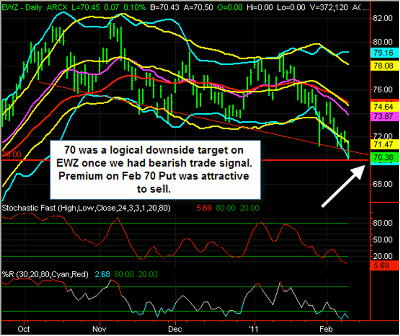I recently put on a bearish put debit spread option trade that performed well and wanted to do a breakdown of the trade for MoneyShow.com readers. Some of you may know this type of trade as a vertical put spread. On the first half of the trade, I took 43% profits in one day, and then closed the remainder of the trade for 100% profits on Thursday (Feb. 10).
This was a great trade, and of course, it doesn't happen every time, but this ETF option trade worked out well, and so I wanted to give you some information regarding why.
First, the trade set-up: This trade was done with options on the iShares MSCI Brazil Index Fund (EWZ).
The trade signal was based on our Daily ETF Tradr system, which incorporates several indicators including a smoothed, optimized Stochastic (similar, but a bit different than Percent R), exponential moving averages, and negative volume index. We focus on a key group of less than 30 liquid ETFs in a variety of manners-with special attention paid to having ETFs in the screen that differ in terms of trading performance (AKA don't all move in tandem).
Anyway, our bearish EWZ signal was confirmed for February 2. We decided to go for a February debit spread on EWZ, rather than just a straight put purchase, due to the higher price/higher volatility of the ETF and its options. Selling a lower put against the one we purchased lowers the overall out-of-pocket cost and also basically gives us a synthetic entry point below the intrinsic value of the higher put.
We received an excellent question from a subscriber on the day of the trade about why we chose to do this debit spread instead of a straight put purchase. Here was some of my response to that question:
From the February 2, 2011 ETF Tradr Portfolio Update:
"We had a great subscriber question today about why we chose to do a debit spread on EWZ rather than just buying the Feb 78 put and other aspects of the trade-here is some of the trade choice rationale for all of our ETF Tradr clients: First, if you are unable or do not desire to trade the spreads, you are welcome on your own to purchase a single option outright when those recommendations come in (but for auto-traders it will be executed as listed on the alert).
Now, in this case, this is higher priced and more volatile ETF as we mentioned, so first off we lower the cost out-of-pocket by simultaneously buying one put and selling another against it in one spread trade. In today's trade, we lowered the cost of the trade by over 10% by doing the spread versus the straight put. Now, we have limited our maximum profit on the trade by doing this . the most this spread can be worth is $8 (78 minus 70 spread)-however, with only paying $3.20 for the spread, our maximum profit is still a very healthy 150%, or $4.80 (8 minus 3.2).
Additionally, we lowered the "synthetic" cost of our bearish entry level
on this position to about 74.8 (based on the average price our auto-traders were
filled of 3.2), while EWZ was at the time at 74.83 or so. So basically the
spread allowed us to do the trade for no time premium in the options-and we like
that. As far as closing out the trade, these spreads should be done as one
single trade. So when we close it out, we close out both legs also as a
single trade.
This one moved quickly in our favor and is already
over 20% profitable as of today's prices. If EWZ moves right down to the 70
level, a spread could potentially get a bit trickier than a normal put,
depending on how far we are from expiration, but the premium on the 70 put that
we sold will eventually erode, and there is very little premium on the 78 put
that we purchased.
Just a few educational notes on our perspective of why spreads are very attractive at times and are a part of the current ETF Tradr portfolio."
So basically, with debit spreads (our preferred method is to buy a deep in-the-money (ITM) option and sell an at-the-money (ATM) or out-of-the-money (OTM) option), you can make a strong profit (but the maximum gain is less than outright call/put purchase), lower your out-of-pocket cost, and get into a position for little or no time premium. There is risk on virtually every options trade, of course, no matter what strategy you employ.
By Moby Waller of BigTrends.com























